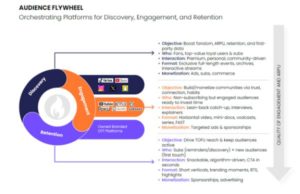TAG Video Systems – Unlock business success in the cloud: gain unmatched agility and efficiency

Paul Schiller, Product Marketing Manager, TAG Video Systems
In the fast-paced landscape of the broadcast and media industries, staying ahead of the technology curve requires adaptability and agility. To overcome the limitations of hardware-specific devices and embrace the future, broadcasters, content providers and distribution and delivery service providers are turning to cloud-based solutions. By transitioning to the cloud, they can unlock new levels of flexibility, efficiency, and scalability. In this article, we will explore the advantages of cloud and cloud-based solutions, overcoming migration challenges, the importance of becoming more agile, cost efficiency and scalability, security and regulatory considerations, and the rapid adoption of IP workflows in the industry.

Embracing cloud for business agility
The transition to cloud infrastructure offers a multitude of advantages for companies committed to achieving greater business agility. By reducing their on-premises footprint and leveraging the power of the cloud, organizations gain the ability to scale resources dynamically, respond quickly to changing demands and technologies, and drive operational efficiency. The cloud promises greater performance, increased availability, and operational cost savings through improved resource allocation and streamlined workflows.
Advantages of cloud-based solutions
Cloud-based solutions bring a host of benefits to media companies. Firstly, they enable increased efficiency and simplified processes. By leveraging cloud technologies, companies can automate manual tasks, leverage artificial intelligence and machine learning capabilities, and optimize their content production and distribution workflows. This results in improved productivity and reduces operational costs.
Moreover, adopting cloud-based solutions leads to the potential for lower administrative costs and centralized data security. With the cloud, businesses can eliminate the need for extensive hardware infrastructure and associated maintenance costs. Additionally, cloud providers offer robust security measures, including data encryption, access controls, and built-in redundancy, ensuring the protection and integrity of valuable content and customer data.
Overcoming challenges in cloud migration
Cloud migration presents its own challenges that need to be addressed for a successful transition. Engaging the right people and acquiring the proper resources and tools to ensure a smooth migration process are significant considerations. This includes training employees on new systems and technologies and potentially re-architecting existing applications for the cloud environment.
Additionally, businesses must consider potential performance issues such as latency and interoperability when moving their workflows and data to the cloud. Ensuring seamless integration of existing systems with cloud-based solutions requires careful planning and testing to avoid downtime and disruptions.
Despite these challenges, the benefits of cloud migration far outweigh the obstacles. Cloud-based solutions’ scalability, cost-efficiency, and enhanced agility justify the effort and investment required to overcome these challenges.
Cost efficiency and scalability
One of the key advantages of cloud-based solutions is cost efficiency. With traditional on-premises infrastructure, businesses often overprovision or underutilize resources. Cloud computing allows organizations to pay only for the resources they use, avoiding unnecessary costs. The ability to scale resources up or down based on demand ensures optimal resource allocation, cost optimization, and increased operational efficiency.
Additionally, cloud infrastructure provides unparalleled scalability. Broadcast companies can easily scale their operations to accommodate growing needs or handle sudden spikes in demand. This scalability allows businesses to deliver content more effectively, improve viewer experiences, and quickly respond to market trends or changes in audience preferences.
Security and regulatory considerations
Data security is a top priority and potential security concerns must be addressed when moving operations to the cloud. Cloud providers offer comprehensive security measures, including robust data encryption, advanced access controls, and regular security audits. It is crucial for organizations to select reputable cloud service providers that comply with industry regulations and standards to ensure data privacy and protection.
Rapid adoption of IP workflows
In addition to cloud migration, the rapid adoption of IP workflows is transforming the media and entertainment industry. Traditional SDI workflows are being replaced by IP-based solutions, which offer greater reliability, scalability, and flexibility. IP workflows allow for seamless integration of different systems and devices, enabling efficient content creation, management, and delivery across multiple platforms. This transition to IP workflows further enhances the agility of broadcast companies, enabling them to respond quickly to changing market demands and reach wider audiences.
Integration of various systems and devices may seem ‘seamless’ or a non-issue to the viewer, but it’s important to consider the multitude of vendors typically involved in IP-based workflows. In some cases, 30-40 or more solutions are stitched together from capture to customer. This is where the TAG Realtime Media Performance platform comes into play, specifically designed to reduce complexity in IP workflows, providing broadcasters with simplicity that minimizes challenges in this intricate landscape. Each of these vendors needs to have a proven track record that delivers on interoperability between all solutions. And TAG Video Systems does just that, ensuring that its 100% software, IP-native solution constantly supports new formats, codecs, and feature requests, maintaining the seemingly increasing pace of industry change. Proper integration of multiple vendors and solutions is crucial in today’s environment, where maintaining stable Quality of Service (QoS) is essential for providing the best Quality of Experience (QoE) to viewing audiences, especially with younger demographics where seconds matter.
That’s a wrap
In the face of a rapidly evolving industry, media companies must prioritize business agility to succeed. Embracing cloud-based solutions, overcoming migration challenges, and adopting IP workflows enable organizations to break free from the limitations of hardware-specific devices and traditional on-premises infrastructure. By transitioning to the cloud and embracing IP workflows, companies can unlock unparalleled flexibility, operational efficiency, scalability, and responsiveness.
The advantages of cloud migration and the rapid adoption of IP workflows empower companies to adapt swiftly to changing market demands, optimize content production and distribution workflows, and remain competitive in the dynamic media landscape.
In conclusion, the path to business agility in the media industry lies in embracing the cloud, overcoming migration challenges, and leveraging IP workflows. By doing so, organizations can drive innovation, improve operational effectiveness, and position themselves at the forefront of the industry. Embrace the cloud, IP workflows, and the cost efficiency and scalability they provide to unlock the full potential of your media business.









